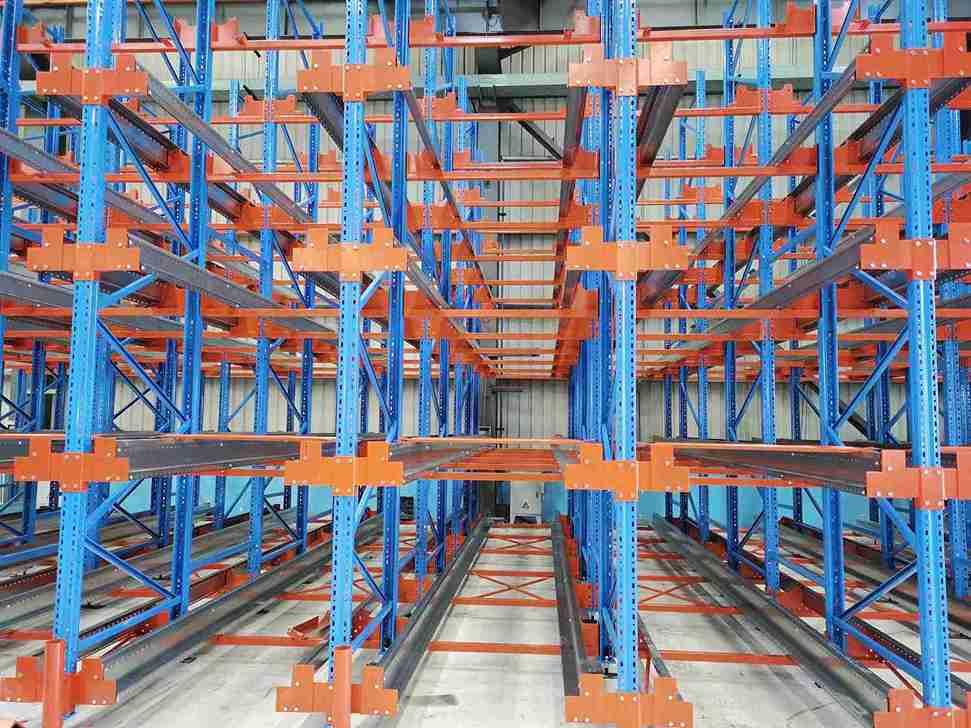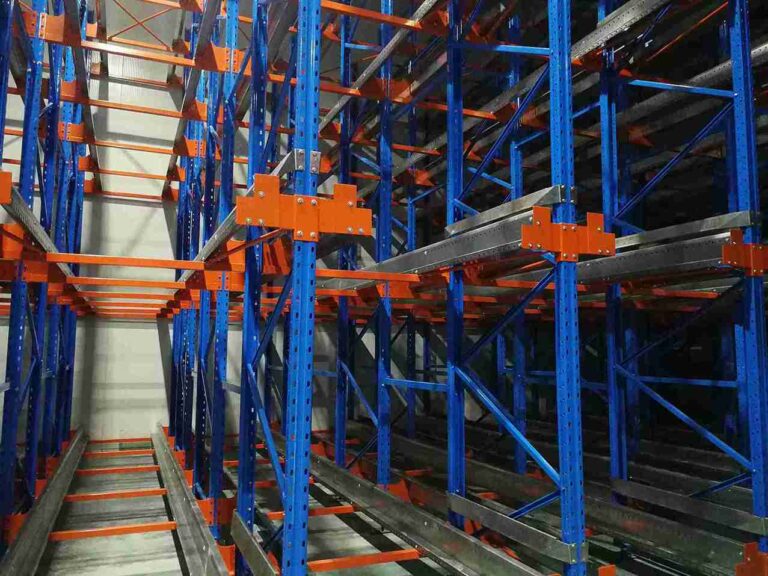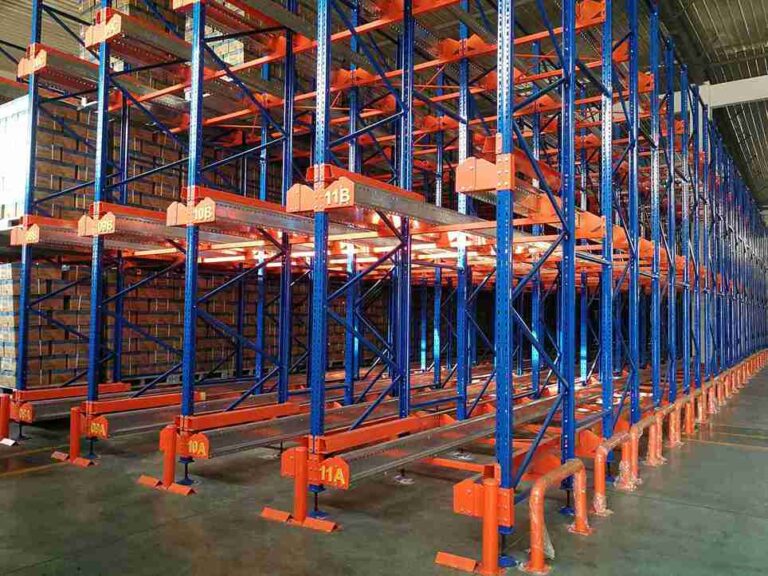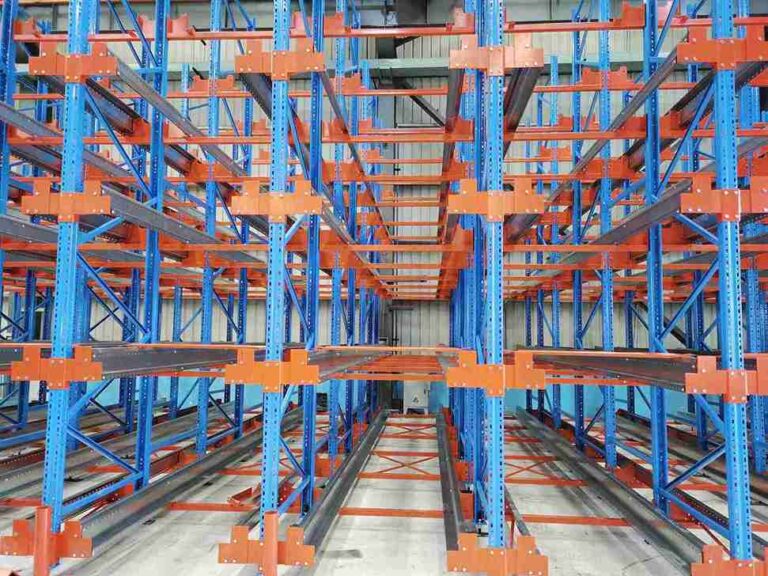📐 "First 50 Enterprise Queries Get Custom 3D Warehouse Design" Plan

In a modern distribution center, the need to maximize warehouse with shuttle rack technology often starts with understanding its operational flow. A shuttle rack system uses a semi-automated shuttle that moves pallets along rails inside storage channels. This shuttle is remotely controlled or integrated into a warehouse management system (WMS), ensuring seamless coordination between forklifts, conveyors, and AGVs.

Pallet Handling Process
Loading – Forklifts place pallets at the entry point of a racking channel. The shuttle cart then positions the pallet deep inside the channel.
Storing – By repeating this process, the system fills the channel, enabling deep-lane storage without forklift entry.
Retrieving – When retrieval is needed, the shuttle moves pallets to the rack’s front, where forklifts or AGVs handle outbound transfers.
This method allows warehouses to maximize warehouse with shuttle rack technology by reducing forklift travel time, minimizing aisle congestion, and ensuring a smoother flow of goods.
Integration with WMS and AGVs
For warehouses moving toward automation, the shuttle rack system seamlessly integrates with warehouse execution software and AGV fleets. This integration creates a synchronized process where shuttles, conveyors, and robotic forklifts work together. As a result, facilities can maximize warehouse with shuttle rack deployment, achieving higher throughput and efficiency while preparing for Industry 4.0 standards.
Key Applications of Shuttle Rack Systems Across Industries
Shuttle racks are not limited to one sector—they are versatile across industries where maximizing warehouse with shuttle rack systems offers significant ROI.
Food & Beverage: High-volume SKUs stored in cold storage environments benefit from shuttle racks, which reduce forklift time inside freezers.
Retail & E-commerce: Shuttle racks support rapid inventory turnover, helping retailers maximize warehouse with shuttle rack technology to meet fast-changing consumer demands.
Pharmaceutical & Healthcare: Shuttle systems ensure safe, efficient storage of sensitive goods while optimizing space.
Automotive & Manufacturing: Large parts and components require dense storage. Shuttle racks help manufacturers maximize warehouse with shuttle rack solutions while integrating automation.
By tailoring solutions to each industry, companies can effectively optimize operations, reduce costs, and improve supply chain responsiveness.
Why Source Shuttle Rack Solutions from a China Manufacturer
China has become the world’s hub for warehouse equipment manufacturing, especially when companies seek to maximize warehouse with shuttle rack investments.
Cost Advantage
One of the main reasons international buyers prefer China manufacturers is cost competitiveness. Chinese factories leverage large-scale steel production and advanced fabrication technologies, allowing businesses to maximize warehouse with shuttle rack solutions at significantly lower capital investment compared to Western suppliers.
Engineering Expertise and Global Supply Chain
Many leading China manufacturers export shuttle rack systems to Europe, North America, and the Middle East. Their engineering teams design racks compliant with international standards (FEM, RMI, CE), ensuring that companies can maximize warehouse with shuttle rack without compromising safety or durability.
Customization and OEM Options
Chinese suppliers often provide OEM and fully customized designs tailored to specific load capacities, warehouse layouts, and automation requirements. This flexibility helps global buyers maximize warehouse with shuttle rack systems aligned with their exact needs.
Comparing Shuttle Rack Systems with Alternative Storage Solutions
Warehousing solutions are diverse, but when companies analyze options to maximize warehouse with shuttle rack systems, the benefits stand out.
Selective Pallet Racking – Low density but high selectivity. Shuttle racks outperform in space utilization.
Drive-in Racking – Provides deep-lane storage but requires forklifts to drive into racks, causing slower throughput and safety risks. Shuttle racks allow businesses to maximize warehouse with shuttle rack technology while eliminating forklift entry.
Automated Storage and Retrieval Systems (AS/RS) – Fully automated but often higher in cost and complexity. Shuttle racks provide a more cost-effective way to maximize warehouse with shuttle rack capabilities while preparing for future automation.
Planning and Designing Your Shuttle Rack Project
Proper design is essential when businesses aim to maximize warehouse with shuttle rack implementation.
Warehouse Assessment
Before installation, it is critical to analyze floor layout, ceiling height, forklift access, and inventory turnover. These factors determine the rack depth and shuttle requirements.
Load Capacity and Safety Standards
Every shuttle rack must meet strict safety requirements, ensuring the system can safely handle dynamic loads. This allows companies to maximize warehouse with shuttle rack while maintaining worker safety and product integrity.
Future Scalability
A well-designed project anticipates future growth. By leaving expansion space, businesses can maximize warehouse with shuttle rack solutions today while scaling up when demand increases.
Case Studies: Success Stories of Shuttle Rack Implementation
Cold Storage Facility in Europe: A food distributor used shuttle racks to store frozen goods, achieving a 70% increase in density. The project proved that they could maximize warehouse with shuttle rack systems even in temperature-sensitive environments.
E-commerce Distribution Center in the U.S.: By adopting shuttle racks, an e-commerce giant doubled throughput, reduced labor costs by 40%, and managed peak-season demand effectively. Their ability to maximize warehouse with shuttle rack solutions became a key competitive advantage.
Automotive Manufacturer in Asia: Shuttle racks allowed a major automotive supplier to store large, heavy parts with ease, showing how manufacturers can maximize warehouse with shuttle rack investments to improve efficiency.
How to Maximize ROI with Shuttle Rack Systems
Investing in shuttle racks is not just about storage; it’s about financial returns. To truly maximize warehouse with shuttle rack ROI, businesses should focus on:
Labor Savings: Reduced forklift travel means fewer operators are required.
Energy Efficiency: Less forklift activity lowers fuel or electricity usage.
Inventory Control: Integrated systems prevent errors and reduce product damage.
Space Optimization: Postponing the need for warehouse expansion saves millions in real estate costs.
Choosing the Right China Shuttle Rack Manufacturer
Selecting the right partner is critical to successfully maximize warehouse with shuttle rack projects. Buyers should evaluate:
Certifications and Standards Compliance (ISO, CE, FEM).
Engineering Support (structural analysis, 3D layout design).
After-Sales Service (installation, training, spare parts availability).
Export Experience (track record in overseas projects).
The best China manufacturers offer end-to-end solutions, helping companies maximize warehouse with shuttle rack systems while ensuring smooth implementation.
Conclusion: The Future of Smart Warehousing with Shuttle Racks
The shift toward automation, high-density storage, and digital integration is reshaping global logistics. Businesses that embrace this trend can maximize warehouse with shuttle rack technology, transforming traditional warehouses into efficient, future-ready distribution centers. With China manufacturers leading innovation and offering cost-effective solutions, global enterprises now have access to smart racking systems that boost efficiency, reduce costs, and provide long-term scalability.
In the future, the ability to maximize warehouse with shuttle rack will not just be a competitive advantage—it will be a necessity for survival in global supply chains.
FAQs
Q1: How does a shuttle rack system differ from drive-in racking?
Shuttle racks eliminate the need for forklifts to enter storage lanes, allowing businesses to maximize warehouse with shuttle rack solutions while increasing safety and speed.
Q2: Can shuttle racks be used in cold storage warehouses?
Yes. Shuttle racks are ideal for cold environments, helping operators maximize warehouse with shuttle rack systems while minimizing forklift exposure to low temperatures.
Q3: How long does it take to implement a shuttle rack system?
Project timelines vary, but with proper planning, businesses can maximize warehouse with shuttle rack installations within 3–6 months.
Q4: Are shuttle rack systems compatible with AGVs and WMS?
Absolutely. Shuttle racks integrate seamlessly with AGVs and software, enabling companies to maximize warehouse with shuttle rack capabilities in automated environments.
Q5: Why are China manufacturers preferred for shuttle rack systems?
They offer cost savings, customization, and global expertise, allowing businesses to maximize warehouse with shuttle rack investments without overspending.
Welcome to contact us, if you need warehouse rack CAD drawings. We can provide you with warehouse rack planning and design for free. Our email address is: jili@geelyracks.com




